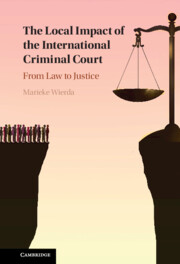132 results
Perceptions of Healthcare Workers on the Attributes of the Integrated Disease Surveillance and Response System in Zimbabwe
-
- Journal:
- Disaster Medicine and Public Health Preparedness / Accepted manuscript
- Published online by Cambridge University Press:
- 16 May 2024, pp. 1-19
-
- Article
- Export citation
Parents’ perceptions of the Tasmanian School Lunch Project - interim findings
-
- Journal:
- Proceedings of the Nutrition Society / Volume 83 / Issue OCE1 / April 2024
- Published online by Cambridge University Press:
- 07 May 2024, E27
-
- Article
-
- You have access
- Export citation
Knowledge, perceptions and practices towards diabetes risk in sub-Saharan Africa: a mixed-methods scoping review
-
- Journal:
- Public Health Nutrition / Volume 27 / Issue 1 / 2024
- Published online by Cambridge University Press:
- 27 March 2024, e104
-
- Article
-
- You have access
- Open access
- HTML
- Export citation
7 - Operationalising Distinction in South Sudan
-
-
- Book:
- Civility, Barbarism and the Evolution of International Humanitarian Law
- Published online:
- 11 January 2024
- Print publication:
- 01 February 2024, pp 135-155
-
- Chapter
- Export citation
Perceptions, barriers and enablers on salt reduction in the out-of-home sectors in Malaysia (MySaltOH) from the perspective of street food vendors, caterers and consumers
-
- Journal:
- Public Health Nutrition / Volume 27 / Issue 1 / 2024
- Published online by Cambridge University Press:
- 15 December 2023, e12
-
- Article
-
- You have access
- Open access
- HTML
- Export citation
Examining How Young Adults Perceive, Understand, and Respond to SARS-CoV-2 Variants in Canada and France: Implications for Public Health Preparedness Efforts
-
- Journal:
- Disaster Medicine and Public Health Preparedness / Volume 17 / 2023
- Published online by Cambridge University Press:
- 24 August 2023, e462
-
- Article
-
- You have access
- Open access
- HTML
- Export citation
4 - Can L2 Learners Imagine Advancedness?
- from Part I - Advancedness and the L2 Learner
-
- Book:
- Second Language Identity
- Published online:
- 27 July 2023
- Print publication:
- 10 August 2023, pp 62-90
-
- Chapter
- Export citation
7 - A Qualitative Analysis of Language Professionals’ Descriptions of Their Ideology and Assessment of Advanced L2 Spanish
- from Part II - Variable Notions of Advancedness
-
- Book:
- Second Language Identity
- Published online:
- 27 July 2023
- Print publication:
- 10 August 2023, pp 138-168
-
- Chapter
- Export citation
Introduction
-
- Book:
- The Local Impact of the International Criminal Court
- Published online:
- 06 July 2023
- Print publication:
- 20 July 2023, pp 1-8
-
- Chapter
- Export citation
7 - Societal Impact II
-
- Book:
- The Local Impact of the International Criminal Court
- Published online:
- 06 July 2023
- Print publication:
- 20 July 2023, pp 217-260
-
- Chapter
- Export citation
Postscript
-
- Book:
- The Local Impact of the International Criminal Court
- Published online:
- 06 July 2023
- Print publication:
- 20 July 2023, pp 282-284
-
- Chapter
- Export citation

The Local Impact of the International Criminal Court
- From Law to Justice
-
- Published online:
- 06 July 2023
- Print publication:
- 20 July 2023
Success Semantics, Reinforcing Satisfaction, and Sensory Inclinations
-
- Journal:
- Dialogue: Canadian Philosophical Review / Revue canadienne de philosophie , First View
- Published online by Cambridge University Press:
- 04 July 2023, pp. 1-12
-
- Article
-
- You have access
- Open access
- HTML
- Export citation
Community perceptions of environmental water: a review
-
- Journal:
- Environmental Conservation / Volume 50 / Issue 2 / June 2023
- Published online by Cambridge University Press:
- 27 March 2023, pp. 73-82
-
- Article
-
- You have access
- Open access
- HTML
- Export citation
‘Some of my patients only come to renew their prescriptions. They are not interested in any additional advice or support’. Physicians’ perceptions on their roles in cardiovascular diseases risk reduction and management in Fiji
-
- Journal:
- Primary Health Care Research & Development / Volume 24 / 2023
- Published online by Cambridge University Press:
- 08 February 2023, e11
-
- Article
-
- You have access
- Open access
- HTML
- Export citation
Perceptions of animal welfare and exotic pet ownership in China
-
- Journal:
- Animal Welfare / Volume 30 / Issue 2 / May 2021
- Published online by Cambridge University Press:
- 01 January 2023, pp. 169-178
-
- Article
-
- You have access
- Export citation
Biased perceptions about momentum: Do comeback teams have higher chances to win in basketball overtimes?
-
- Journal:
- Judgment and Decision Making / Volume 15 / Issue 4 / July 2020
- Published online by Cambridge University Press:
- 01 January 2023, pp. 545-560
-
- Article
-
- You have access
- Open access
- HTML
- Export citation
Spontaneous associations and label framing have similar effects in the public goods game
-
- Journal:
- Judgment and Decision Making / Volume 9 / Issue 5 / September 2014
- Published online by Cambridge University Press:
- 01 January 2023, pp. 360-372
-
- Article
-
- You have access
- Open access
- HTML
- Export citation
American attitudes toward nudges
-
- Journal:
- Judgment and Decision Making / Volume 11 / Issue 1 / January 2016
- Published online by Cambridge University Press:
- 01 January 2023, pp. 62-74
-
- Article
-
- You have access
- Open access
- HTML
- Export citation



